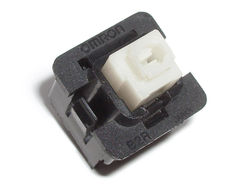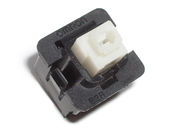Omron B2R series
| This article requires additional photographic illustration |
 | |
| Manufacturer | Omron |
|---|---|
| Switch type | Linear |
| Sense method | Reed |
| Total travel | 4 mm |
| Keycap mount | Proprietary |
| Switch mount | Plate mount |
Omron B2R series is a series of reed switches. A subset of this series, the "M" types, uses solder terminals and is suitable for use in keyboards. This page primarily covers the "M" types only.
Contents
Description
The switches are branded "OMRON" on the top, as well as being marked "B2R" and "JAPAN". The front of each switch is marked in white paint with what appears to be the model number, along with the lot number.
Known designs are SPST only, with a single reed module compartment. B2R features both upstroke and downstroke damping using separate rubber rings. Different models within the series provide illumination, alternate action and potentially an additional operation mode yet to be discovered.
B2R-M has a single-piece shell. The slider is inserted in from the top, and the reed module is inserted in from below. Considerable force is required to remove each of these parts, and damage may ensue from attempted disassembly, as noted later.
The downstroke is damped by a rectangular rubber pad which fits around the bottom of the slider and comes to rest against two small posts. The upstroke is damped by a second rubber part, which fits into a groove within the slider. A small piece of this part protrudes outwards above a corresponding protrusion in the slider itself, and this comes to a stop against a downward-facing ledge that is formed from the top of a shallow recess in the wall of the slider chamber.
The slider and reed module have separate chambers within the switch, with a wall in between them. The reed module comprises a plastic block into which the terminals are placed; in type M switches, this appears to be moulded as a single unit with the factory and cannot be disassembled, but in type G switches this block appears to be a separate carrier from which the terminals and reed capsule assembly can be removed.
The return spring (or springs, in illuminated variants) is offset to the back of the slider. In front of this is the magnet. The slider chamber features a special ridge, designed to hold in place either one or two return springs, depending on whether or not the switch is illuminated.
The front of the shell is recessed and has two guides, a notch, a step and a circular hollow post. Additional parts can be mounted onto the front. The slider does not protrude into this region and cannot influence its behaviour directly, but there is a tapered recess in the front of the slider that appears to be designed to rotate a lever, and one that could pivot from the hollow post directly below it. Possible explanations include an alternate action latching mechanism and a physical shift lock assembly.
Keycap mount
The keycap mount appears to be wholly proprietary. Ignoring the lamp fittings, it is a block around 5.2 mm wide by 5.0 mm deep and around 3.45 mm tall. Each of the four edges has a small vertical notch cut into it; this is difficult to measure, but it is around 0.7 mm by 0.7 mm (measurements vary from 0.64 to 0.8 mm). Additional grooves run around this block.
Dimensions
Total height from the PCB standoffs to the top of the slider is around 29 mm. The shell is stepped and appears to be designed for two different mounting plate thicknesses or different PCB-to-plate distances, by way of different size holes in the plate. The mounting hole should be around 15.3 mm square, and the PCB-to-plate distance of 14.2 mm. The switch appears to support a slightly larger hole of 17.6 by 15.3 mm; this is in fact a pair of ridges that retain the sealing bellows sometimes seen on these switches. The maximum width and depth of the switch (above the plate) is around 17.6 by 17.7 mm.
The magnet is 6.4 mm wide by 5.9 mm tall by 2.8 mm deep.
Age
The age of the switch is not known. Type "B2R1-M" (which may or may not be part of this series) was discontinued in September 1988, while B2R series as a whole was discontinued in March 1993.[1]
Variants
B2R switches have both 1 and non-1 forms. The meaning of "1" is not known, and the 1 and non-1 forms appear to be identical: B2R-M and B2R-M1 do no differ in exterior appearance or in feel, and B2R-M and B2R-ME1 are have internally identical common parts. B2R-ME1 (depicted on this page) and B2R-ME are visually almost identical, but B2R-ME doesn't have the tapered tips to the terminals.[2] B2R-ME also appears to have a normal black reed module instead of the white module found in B2R-ME1.
The confirmed variants are:
| Part | Description | Target | |
|---|---|---|---|
 |
B2R-M B2R-M1 |
SPST momentary | Keyboards |
 |
B2R-ME B2R-ME1 |
SPST momentary, illuminated | Keyboards |
 |
B2R-G1 | SPST momentary | Other equipment |
Illuminated
The slider supports a centre LED. The LED is an unusual design, and with the legs folded upwards around the switch, it is pressed down into the top of the slider. The single return spring is replaced with two adjacent springs that fit onto short terminals. The top of each spring is straight, and the straight segments are fed through the slider and soldered to the upward-facing legs on the LED. As the LED is factory-fitted and non-removable, the positive and negative LED terminals are marked on the shell, as "K" (cathode) and "A" (anode). A single shell design and single slider design accommodate both return spring arrangements: single centre spring (non-illuminated models) and the two side-by-side springs (illuminated models).
Alternate action
Some discovered sliders have a latch track in the side, and a gap in the shell allows access to this. A protrusion on the shell appears to provide a pivot point for the latch arm. Thus far, this variant has yet to be sighted, so its existence remains hypothetical.
Unknown form
The shell also provide a means to attach additional exterior terminals, held by press fit. Most sliders contain a tapered recess that appears to work in conjunction with this exterior assembly to provide an addition form, such as double action or DPST.
Disassembly
The reed module and slider are held in tightly, and attempting to remove either one risks damaging the switch. Attempting to pull out the reed module carries a minor risk of tearing off one of the legs. Attempting to pull out the slider is much higher risk: it appears to be POM, and is very hard and smooth, with very little to grip. The grip force required can crush the keystem, and the extraction force required to clear he slider stop can tear the slider stop apart.
Disassembling the illuminated version is not confirmed to be possible. The slider extraction force is so violent that it can rip the springs apart even though they are not held down and are freely removable. Disassembly likely requires a vice-like jig to hold the switch and slider tightly and pull out the slider slowly and firmly; this would achieve the desired extraction force without runaway motion and prevent damage to the springs. The springs would then come out still attached to the slider, allowing for cleaning to be conducted.
Keyboards
- FANUC System P Model G keyboard
Gallery
B2R-M
The switches pictured were taken from a FANUC keyboard before being sold on AliExpress that appears to have come from a System P Model G.[3]
B2R-ME1
The switches pictured were obtained from community member 10ko, used, and of unknown origin. Of the three (all from the same batch), one has a tapered recess in the slider, and the other two have a latch track, as seen in the example below.
External links
- コントローラ研究室 — ベラボースイッチ特集2(ベラボースイッチ製作) (B2R-G1 disassembly)
- コントローラ研究室 — 押しボタンについて (B2R-G1)












